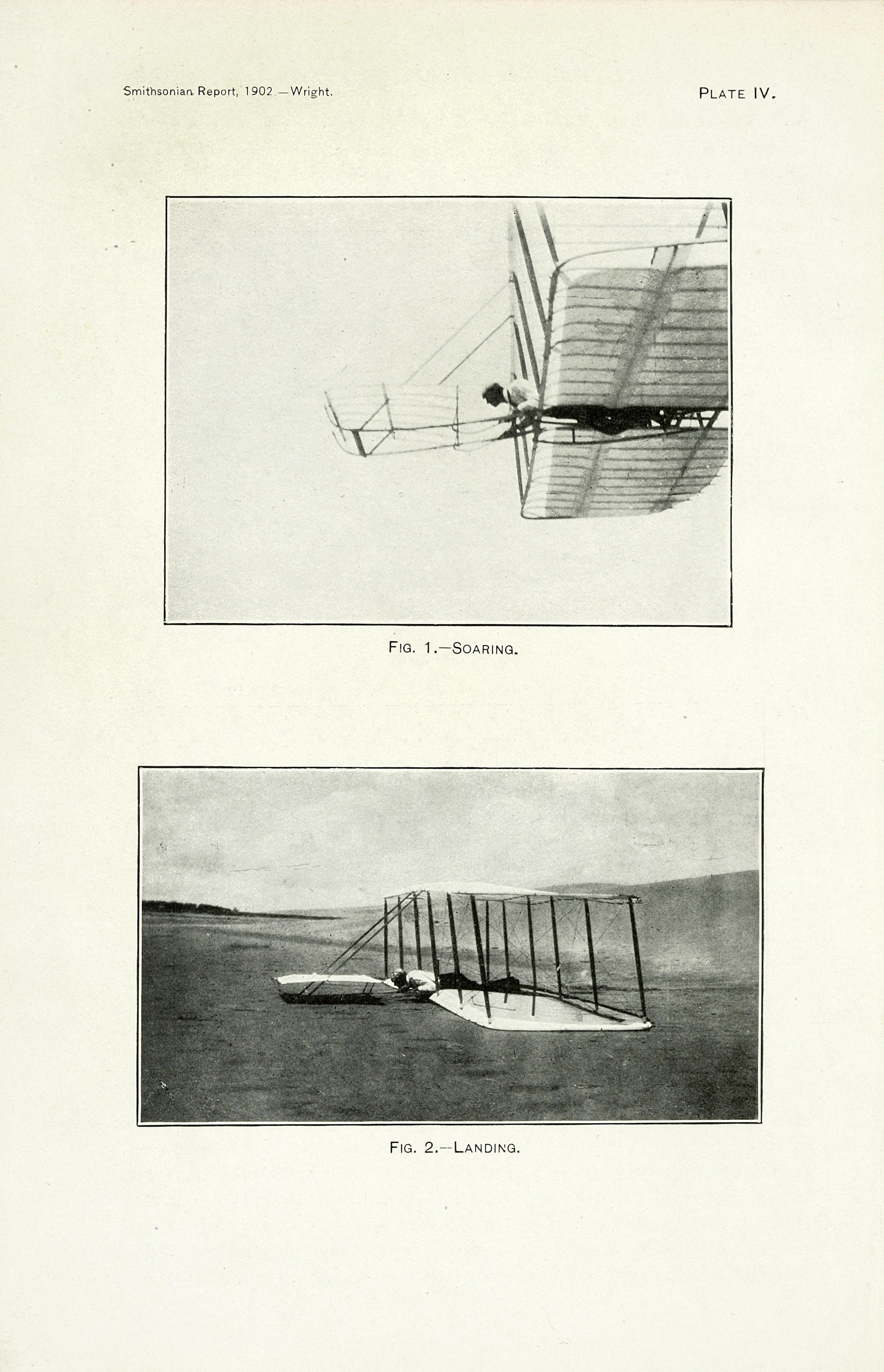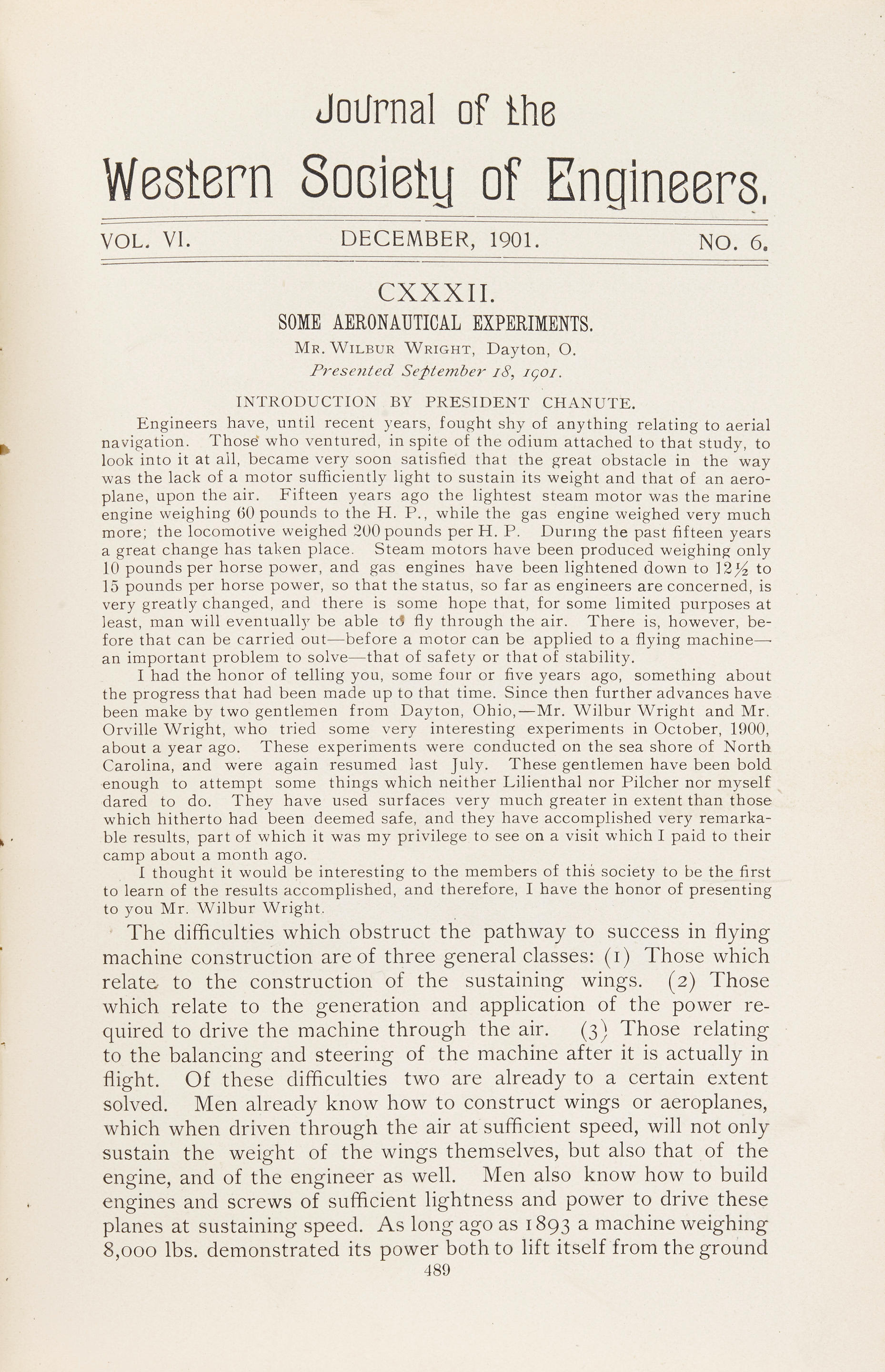WRIGHT, Wilbur (1867-1912). 'Some Aeronautical Experiments', offprint from: Journal of the Western Society of Engineers , vol VI (December, 1901), pp. 489-508. [?Chicago: Octave Chanute, 1901]. 8° (230 x 155 mm). 11 half-tone illustrations, 8 after photographs of the Wright brothers' glider, and 2-line diagrams in text. (Very light rust-staining from staples at inner margin.) Original printed wrappers (very light browning at outer edges, small rust mark from paperclip on upper wrapper, spine partially split). Provenance : pencilled translations of captions into French below 6 illustrations -- Flight-Lieutenant Ralph B. Weller (acquired in North Africa during World War II; loosely-inserted letter to Weller about the offprint). A FINE COPY OF THE FIRST EDITION, OFFPRINT ISSUE, of the Wright brothers' rare first published report of their trial flights with motorless gliders at Kitty Hawk, 'the work that made their experiments famous' (Norman). The brothers Wilbur and Orville Wright, Indiana bicycle manufacturers, had grown interested in the possibilities of human flight following the death of the German aeronaut Otto Lilienthal in 1896. After three years of intensive study of the existing aeronautical literature, the brothers built their first flying machine, a biplane kite-glider with a 5-foot wingspread, modelled upon Octave Chanute's five-plane glider, but incorporating wing-warps--Wilbur Wright's solution to the problem of lateral control. A year later they built their first full-sized glider, with a 17-foot span, and in the summer of 1900 a still larger glider, with a 22-foot wing-span. The present paper describes these progressive developments and the brothers' trial flights at the beach of Kitty Hawk, North Carolina in the summer of 1901, during which they achieved glides of up to 389 feet; discovering from these experiments that 'almost all existing aerodynamic data were erroneous, the Wrights designed a small wind tunnel in which, in the fall of 1901, they tested several hundred model airfoils and obtained reliable lift and drag measurements as well as many other essential aerodynamic data' ( DSB , XIV, p. 520). This important paper was written and read to the Western Society of Engineers on 18 September 1901, at the instigation of its president Octave Chanute (1832-1910), a French-born civil engineer whose own carefully tabulated gliding experiments in 1896 and 1897 paved the way for the Wrights' later successes and whose passion for aeronautics made him an international clearing house for information on aviation. Chanute, the Wright brothers' earliest and most important patron, introduced Wright's paper with prefatory remarks on advances in motor design, which made powered flight a possibility, if problems of stability could be solved, before continuing: 'These gentlemen [the Wright brothers] have been bold enough to attempt some things which neither Lilienthal nor Pilcher nor myself dared to do. They have used surfaces very much greater in extent than those which hitherto had been deemed safe, and they have accomplished very remarkable results, part of which it was my privilege to see on a visit which I paid to their camp about a month ago'. Indeed, Chanute 'was so certain of this paper's significance that he ordered 300 copies of the offprint [for which the type was reset and the text paginated [1]-22], 150 of which he sent to colleagues in the United States and abroad, and 150 of which he sent to the Wright brothers for their use' (Norman). The present copy is probably one of the 150 reserved by Chanute for his own use and sent to a Francophone associate (who presumably was either resident in or moved to North Africa), who has added translations into French of the captions beneath most of the photographs of the Wrights' gliders. The work was then purchased in North Africa by the collector Ralph Weller, who had been posted to the RAF's 114 Squadron in Algeria in November 1942 and remained in North Africa for most
WRIGHT, Wilbur (1867-1912). 'Some Aeronautical Experiments', offprint from: Journal of the Western Society of Engineers , vol VI (December, 1901), pp. 489-508. [?Chicago: Octave Chanute, 1901]. 8° (230 x 155 mm). 11 half-tone illustrations, 8 after photographs of the Wright brothers' glider, and 2-line diagrams in text. (Very light rust-staining from staples at inner margin.) Original printed wrappers (very light browning at outer edges, small rust mark from paperclip on upper wrapper, spine partially split). Provenance : pencilled translations of captions into French below 6 illustrations -- Flight-Lieutenant Ralph B. Weller (acquired in North Africa during World War II; loosely-inserted letter to Weller about the offprint). A FINE COPY OF THE FIRST EDITION, OFFPRINT ISSUE, of the Wright brothers' rare first published report of their trial flights with motorless gliders at Kitty Hawk, 'the work that made their experiments famous' (Norman). The brothers Wilbur and Orville Wright, Indiana bicycle manufacturers, had grown interested in the possibilities of human flight following the death of the German aeronaut Otto Lilienthal in 1896. After three years of intensive study of the existing aeronautical literature, the brothers built their first flying machine, a biplane kite-glider with a 5-foot wingspread, modelled upon Octave Chanute's five-plane glider, but incorporating wing-warps--Wilbur Wright's solution to the problem of lateral control. A year later they built their first full-sized glider, with a 17-foot span, and in the summer of 1900 a still larger glider, with a 22-foot wing-span. The present paper describes these progressive developments and the brothers' trial flights at the beach of Kitty Hawk, North Carolina in the summer of 1901, during which they achieved glides of up to 389 feet; discovering from these experiments that 'almost all existing aerodynamic data were erroneous, the Wrights designed a small wind tunnel in which, in the fall of 1901, they tested several hundred model airfoils and obtained reliable lift and drag measurements as well as many other essential aerodynamic data' ( DSB , XIV, p. 520). This important paper was written and read to the Western Society of Engineers on 18 September 1901, at the instigation of its president Octave Chanute (1832-1910), a French-born civil engineer whose own carefully tabulated gliding experiments in 1896 and 1897 paved the way for the Wrights' later successes and whose passion for aeronautics made him an international clearing house for information on aviation. Chanute, the Wright brothers' earliest and most important patron, introduced Wright's paper with prefatory remarks on advances in motor design, which made powered flight a possibility, if problems of stability could be solved, before continuing: 'These gentlemen [the Wright brothers] have been bold enough to attempt some things which neither Lilienthal nor Pilcher nor myself dared to do. They have used surfaces very much greater in extent than those which hitherto had been deemed safe, and they have accomplished very remarkable results, part of which it was my privilege to see on a visit which I paid to their camp about a month ago'. Indeed, Chanute 'was so certain of this paper's significance that he ordered 300 copies of the offprint [for which the type was reset and the text paginated [1]-22], 150 of which he sent to colleagues in the United States and abroad, and 150 of which he sent to the Wright brothers for their use' (Norman). The present copy is probably one of the 150 reserved by Chanute for his own use and sent to a Francophone associate (who presumably was either resident in or moved to North Africa), who has added translations into French of the captions beneath most of the photographs of the Wrights' gliders. The work was then purchased in North Africa by the collector Ralph Weller, who had been posted to the RAF's 114 Squadron in Algeria in November 1942 and remained in North Africa for most







.jpg)



.jpg?height=400)



Testen Sie LotSearch und seine Premium-Features 7 Tage - ohne Kosten!
Lassen Sie sich automatisch über neue Objekte in kommenden Auktionen benachrichtigen.
Suchauftrag anlegen